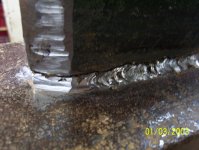Build logsplitter.
Cleaned out the back shed, put it all inna pile and welded it together.
Ground away everything that didn't look like a logsplitter.
7 1/2 facecords of knarly hickory later, my knife has torn loose from the 10 inch ibeam.
Knife was made of two 1/2 inch grader cutting edges, welded back to back.
Backup gussett is of 1 inch CRS that had laying around.
Welded together with Lincoln 225 buzzbox, 5/32 6013 set on 180 amp.
Gonna try to post a picture.
The CRS gussett held!
Weld is torn where it meets the harder (Grader Blade) steel and some right thru the center of the weld.
Gotta try ta get that puppy back offa there, regrind all way around, then open to suggestions as to where I went horribly wrong!
Cleaned out the back shed, put it all inna pile and welded it together.
Ground away everything that didn't look like a logsplitter.
7 1/2 facecords of knarly hickory later, my knife has torn loose from the 10 inch ibeam.
Knife was made of two 1/2 inch grader cutting edges, welded back to back.
Backup gussett is of 1 inch CRS that had laying around.
Welded together with Lincoln 225 buzzbox, 5/32 6013 set on 180 amp.
Gonna try to post a picture.
The CRS gussett held!
Weld is torn where it meets the harder (Grader Blade) steel and some right thru the center of the weld.
Gotta try ta get that puppy back offa there, regrind all way around, then open to suggestions as to where I went horribly wrong!

